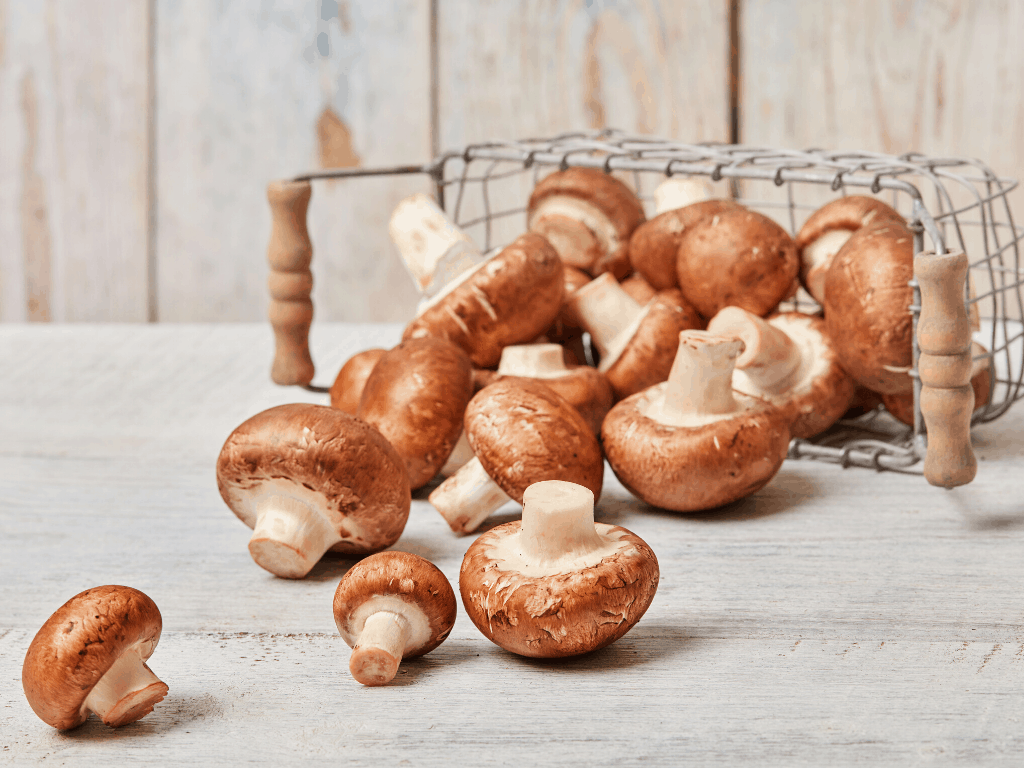Nothing adds to the flavor and texture of a dish like the earthy crunch of a well-prepared mushroom. You can find fresh or dried common edible mushrooms in many grocery stores, health food stores, and farmers’ markets. But if you’re new to cooking with mushrooms, you may be wondering what mushroom to choose, what dish it works with, and how to cook it.
What mushroom holds up well in a soup, or on the grill?
Here, this guide to 7 common edible mushrooms will help you experiment with different types of edible mushrooms, enhancing the flavor and texture of many dishes.
Like This Article? Pin it on Pinterest

1. White Button
White buttons are what a lot of people think of when you say “mushrooms.” These are the typical grocery store mushrooms also common in takeout meals. People often think white button mushrooms are bland and spongy, but this isn’t warranted if they’re prepared properly.
White mushrooms can be crisp and full of flavor and protein. To prepare white buttons, rinse them for only a few seconds so they don’t get too wet. Sauté them briefly with some oil in a pan, making sure not to crowd them, or they won’t get as crisp. Then add them to a dish, or eat them on their own. They can also be chopped and added to a salad.
2. Portabella
Portabellas are a common item in the grocery store and are actually fully mature White Button mushrooms. They are a delight to cook because they stay firm when heated. Portabellas are ideal to be used as a meat substitute, such as in place of a beef patty in a burger. They can be grilled, sautéed, added to a stir-fry, or tossed in a pasta sauce. Portabellas have a unique, meaty texture and are rich in Vitamins D and Vitamin B both of which contribute to increasing energy in the body. During the winter months, there is a sharp increase in Vitamin D deficiency since Vitamin D production in our bodies comes from exposure to sun. Some important benefits of Vitamin D includes promoting healthy bones and teeth and plays a role in regulating the immune system.
3. Cremini
White Buttons, Creminis, and Portabellas are all the same species of mushroom. In fact, Cremini mushrooms are the same exact “agaricus bisporus” species as White Button mushrooms, but they are aged longer. Creminis have a similar flavor but slightly firmer texture than buttons, making them ideal in hearty stews and soups, casseroles, and other dishes with a high liquid content.
4. Shiitake
Shiitake mushrooms are also relatively common, and are packed with vital nutrients and minerals, as well as cancer-fighting antioxidants. Shiitakes can be purchased dried or fresh. Add dried Shiitakes directly to a dish, or soak them first in hot water until they “plump up,” and then add them. If the mushrooms are fresh, remove the stems, sauté them and add them to your dish. Shiitakes go great in stir-fry and soup, they can be added to a pizza, and they can even be sautéed and thrown in with eggs.
5. Morel
Morels are commonly found in wooded areas with downed trees, making them almost as fun to hunt for as they are delicious to eat. Morels can be expensive, so an avid mushroom hunter prefers to find their own. Make sure you know what you’re looking for, as poisonous mushrooms mimic the appearance of the morel. Morels are nutrient-dense mushrooms, known for their distinct earthy flavor. To prepare morels, try sautéing them in olive oil and either a splash of white wine or heavy cream – or both. Check out our cooking tips on how to prepare these tasty fungi.
6. Lion’s Mane
Lion’s Mane mushrooms have an impressive list of possible medicinal benefits:
- They help fight cancer
- They boost the immune system
- They help fight off depression
- They aid in digestion
- They help protect the brain
- They can even speed up the healing process
Lion’s Mane mushrooms are also a good source of protein, and are best when thoroughly baked or sautéed, as they can be a bit bitter otherwise.
7. Reishi
The Reishi mushroom also has a long list of medicinal benefits. Reishi mushrooms are found mainly in Asia, and act as a natural sleep aid, boost the immune system, fight cancer, combat allergies, and help balance blood sugar. Reishi can be taken as a health supplement, eaten cooked, or, more commonly, ground into a powder and added to a drink, such as a smoothie, or sprinkled on a dish. Reishi is also great for stewing to prepare tea, or cooking and adding to soup.
Final Thoughts
Mushrooms are a healthy and delicious addition to any meal. Cooking with common edible mushrooms is surprisingly simple, and it can bring any recipe to a new level of flavor and texture.
Mushrooms have a place in any kitchen by adding protein, antioxidant benefits, and fiber content, as well as medicinal benefits and flavor.






